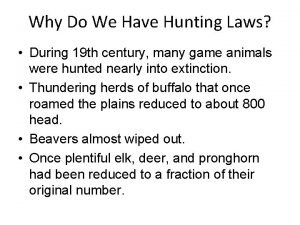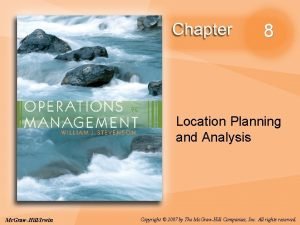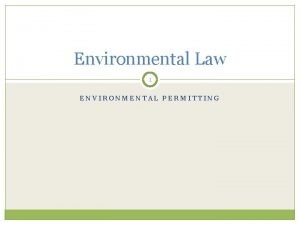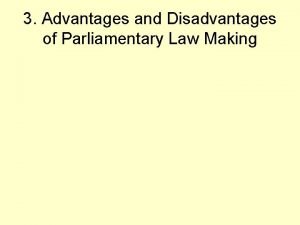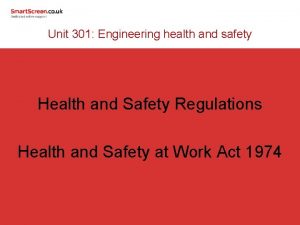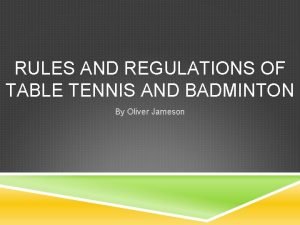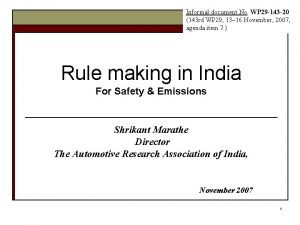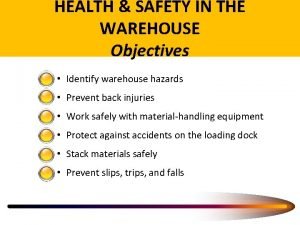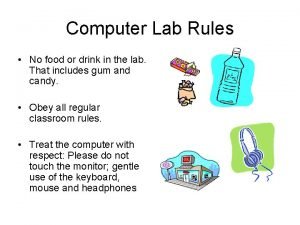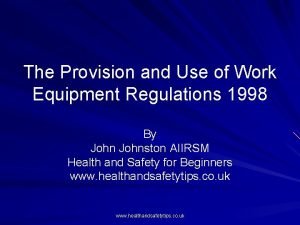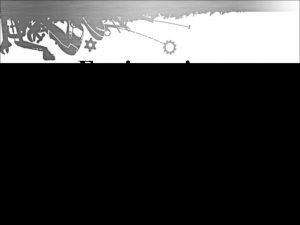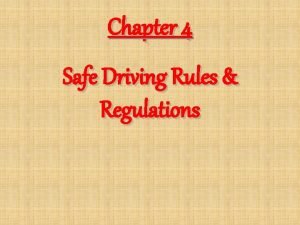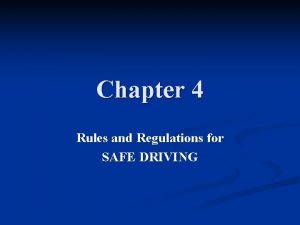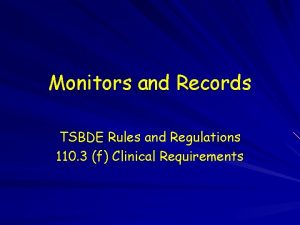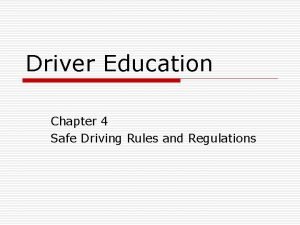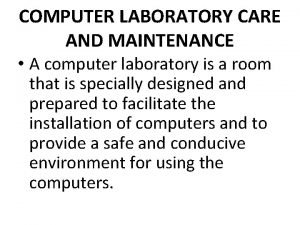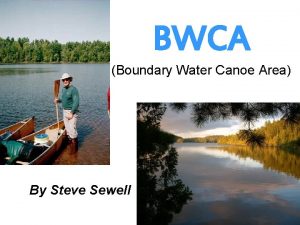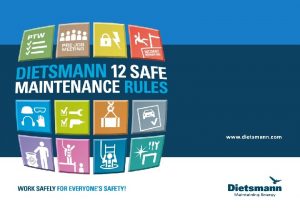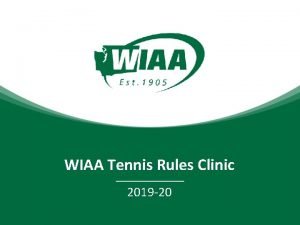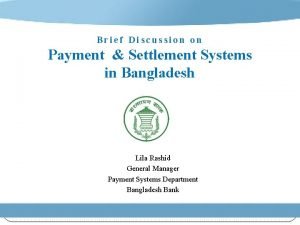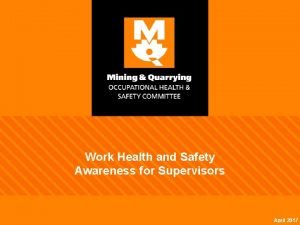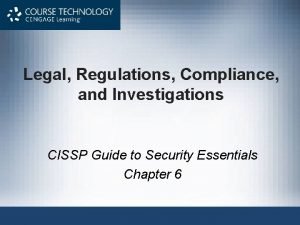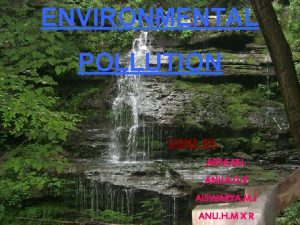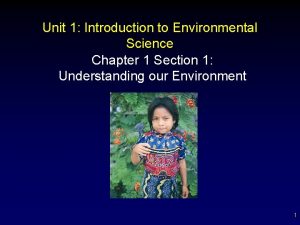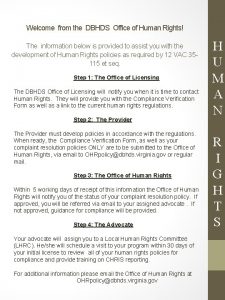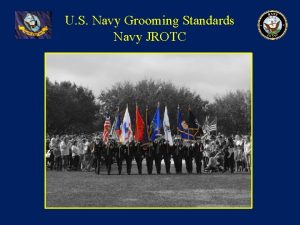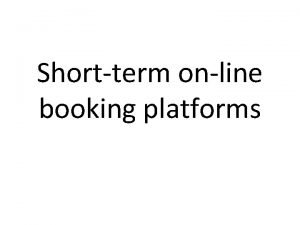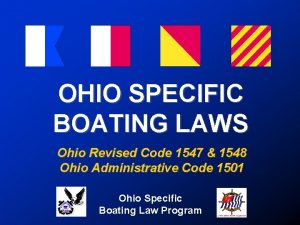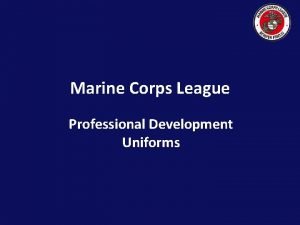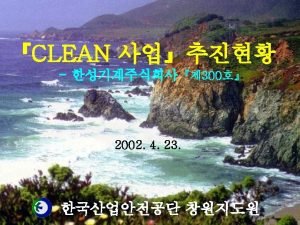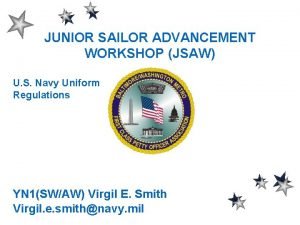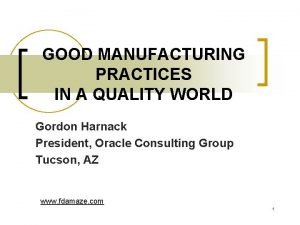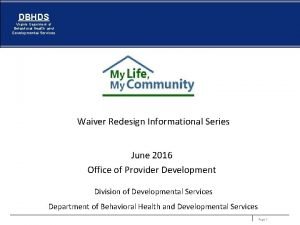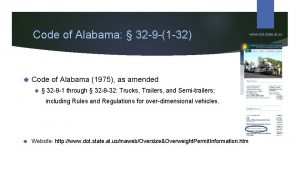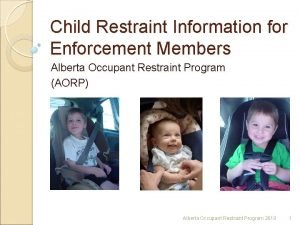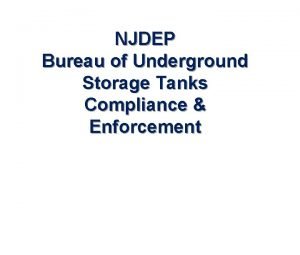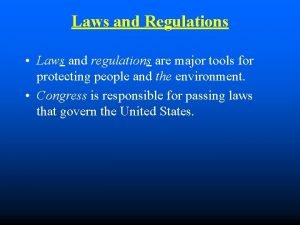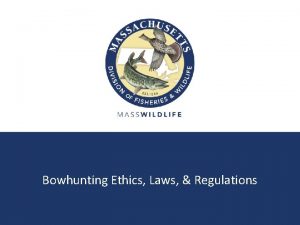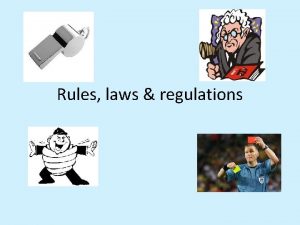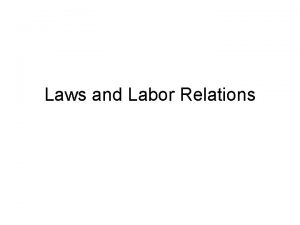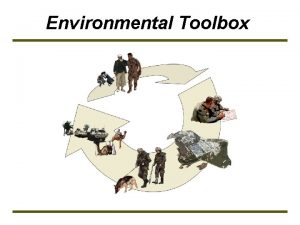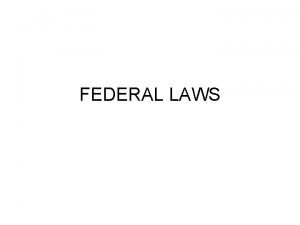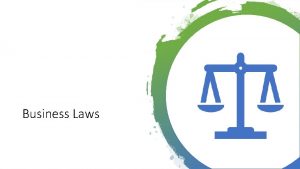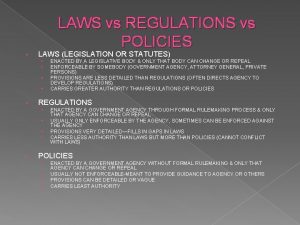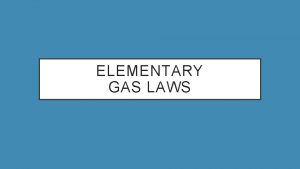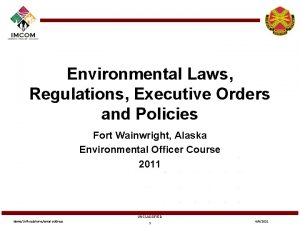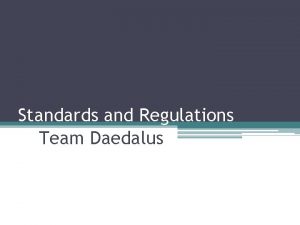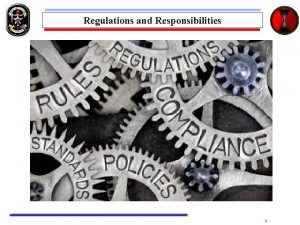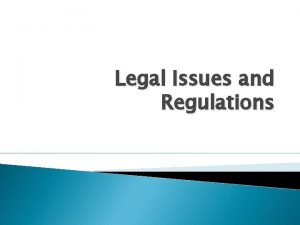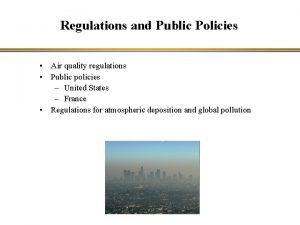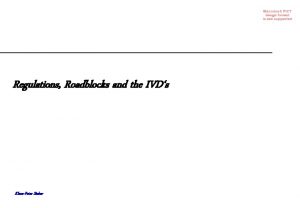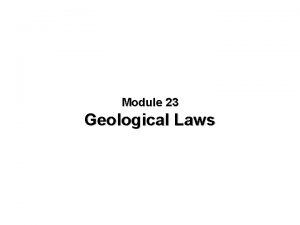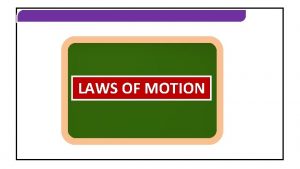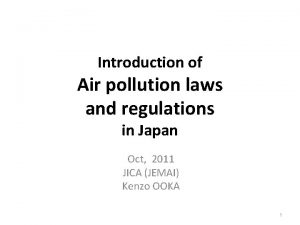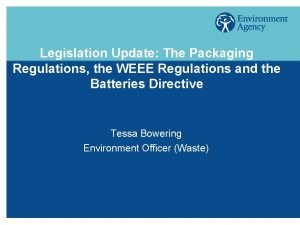Environmental Laws Regulations Introduction to Environmental Laws and

























































- Slides: 57

Environmental Laws & Regulations

Introduction to Environmental Laws and Regulations Where did all the environmental laws come from?

How the Environmental Laws Work Federal Government Executive Legislative EPA Congress initiates legislation and passes a law EPA interprets the law and writes the rulebook Committees review the laws and amend them as necessary Certain laws are enforced on a federal level Judicial Individual states take the law and pass it on the state level State agencies take the rules from the EPA and enforce the laws

Enforcement Options n Conservation means management of resources n Preservation means management but you cannot n n disturb the area Restoration means you return area to the original condition (not very realistic) Remediation is a general term that means cleaning up (most common term used) Mitigation means repairing an affected area, usually by replacing it somewhere else (wetlands) Reclamation means you are recovering resources or land from contaminated sites (recovering metal from electronics)

Awareness of Our Environment n We are much more aware of how our actions effect the environment today n Organizations such as Sierra Club, Chesapeake Bay Foundation and Ducks Unlimited help raise awareness n Involvement has increased -community meetings -protests -volunteers

Silent Spring, by Rachel Carson n Rachel Carson was a biologist, a naturalist and an accomplished writer n Her book took over 2 years to write n Although industry touted it as the writings of an hysterical woman, the country and the government sat up, listened and became “aware” of the damage being caused and began to react

Cuyahoga River, Ohio n In the late 60’s the Cuyahoga River, which is located in Northeast Ohio, caught on fire The river was one of the most polluted rivers in the US. n It has actually caught on fire several times. n n This event inspired the environmental movement.

Love Canal l Land around Niagara Falls, New York was a disposal area for Hooker Chemical Company Developers built a “dream” community on the property Highly toxic materials began to leech into the local water system

Love Canal (continued) l l l President Carter declared the land a Federal Disaster Area on August 7, 1978 Residents abandoned homes and businesses and cleanup began This is the incident that prompted CERCLA (clean-up provisions)

Times Beach n Dioxin contaminated oil was sprayed on dirt roads and fields to control dust n EPA tested the soil and found dangerous levels of dioxins n Residents had to abandon the community in 1983 n Incinerators were built on-site to dispose of the contaminated soil

How do these laws affect me? n Citizens elect state and federal legislators n Legislators introduce legislation based on the constituency n State and Federal laws are passed that regulate the businesses and industries that generate hazardous or dangerous chemicals

The Environmental Protection Agency n Created in 1970 by President Nixon n Replaced the Environmental Health Service n Mission Statement is to Protect the Environment for our generation and future generations

National Environmental Policy Act (NEPA), 1969 n Declared a national environmental policy and promotes consideration of environmental concerns by federal agencies n Title I: declared a national environmental policy and goals, provides a method for accomplishing these goals and includes guidance

NEPA (continued) n Title II: created the Council on Environmental Quality (CEQ) and its responsibilities n An Environmental Impact Study (EIS) may be required if a proposed action that may affect the quality of the human environment

Clean Air Act History n In 1963, the Clean Air Act was first passed with regulatory language n Grants were provided for air pollution control agencies and established a pollution abatement conference procedure n In 1965, Congress added Title II, The Motor Vehicle Air Pollution Control Act which provided emission standards

Clean Air Act of 1970 n EPA had the authority to establish regulatory goals and standards n Standards for 50 industrial processes were developed n 189 Pollutants were initially regulated n Permit requirements were established n Criminal sanctions for non-compliance were established

Clean Air Act (continued) n National Ambient Air Quality Standards (NAAQS): primary and secondary standards for each pollutant to protect public health n Air Quality Control Regions (AQCR) were established n State Implementation Plans (SIPs): states were given the task of setting the regulatory structure to achieve the NAAQS

Clean Air Act (continued) n Attainment: If an area has achieved the NAAQSs for a parameter, it is considered to be in attainment status n Nonattainment Areas: Those areas where the NAAQSs have not been achieved n Title V

National Emission Standards for Hazardous Air Pollutants n NESHAP is the toxic equivalent to the NAAQSs n If a NESHAP is set for a pollutant, a facility must apply for governmental approval for operation n Asbestos, Benzene, Beryllium, Coke oven emissions, Inorganic Arsenic, Mercury, Radionuclides, and Vinyl Chloride

NESHAP (continued) n New Source or changes to an existing source must be approved by the EPA prior to bringing the process on-line

Occupational Safety and Health Act of 1970 n Created the Occupational Safety and Health Administration under the Department of Labor n Established exposure limitations for 22 hazardous substances and 380 air contaminants (Subpart Z - Toxic and Hazardous Substances) n Required the use of Material Safety Data Sheets (MSDS)

OSH Act (continued) n Established the National Institute for Occupational Safety and Health (NIOSH) n Enforced employer documentation n Established the right to perform inspections

The Clean Water Act History n In 1972, a law was passed to protect the purity of our natural waterways. n In 1977 significant changes were made to the Federal Water Pollution Control Act and the renamed the Clean Water Act.

Clean Water Act Regulations n The Clean Water Act regulates industrial discharge into a navigable waterway.

Navigable? n A “navigable waterway” is any body of water that a vessel can navigate. This includes oceans, lakes, rivers, . . .

…and each little creek, tributary and stream that feeds into a larger more navigable waterway.

CWA Elements n There are five basic program elements: permit program n minimum national effluent standards n water quality standards n toxic chemical or oil spills n construction grant program for POTWs n

CWA Industry Requirements n Established allowable levels of specific pollutants for restricted use n 65 (128) Toxic Pollutants were regulated n Effluent and Pretreatment guidelines were established n Best Available Technology was defined n Spill cleanup provisions were established

CWA (continued) n National Pollutant Discharge and Elimination Systems (NPDES) permitting n n Navigable Waterways Administrated by the State Discharge Monitoring Reports (DMR) Stormwater Discharge n Publicly Owned Treatment Works (POTW) n Administrated by the Municipality

Federal Insecticide, Fungicide & Rodenticide Act of 1972 n Required the registration of all pesticide products used in the US n The EPA can now regulate the use of pesticide products n Substances that may be of a “substantial question of safety” to the public can be “cancelled” n Suspension orders could immediately ban the use of a pesticide product

FIFRA (continued) n Registration is required to be able to purchase and use certain pesticide products n The EPA must consult with the US Department of Agriculture

Safe Drinking Water Act of 1974 n Established Maximum Contaminant Levels for 83 compounds n Defined treatment techniques for specific contaminants n Required filtration and disinfection of potable water n Established programs for underground injection control

SDWA (continued) n Gave the State the responsibility for implementing wellhead protection programs n Defined five classes of wells

Hazardous Materials Transportation Act of 1975 n Required hazardous materials shipments to be packaged, labeled and transported according to Department of Transportation (DOT) requirements n Established hazard classes n Required carriers to report all spills and emergency incidents concerning hazardous materials to the DOT within 15 days

Toxic Substances Control Act of 1976 n Established a 90 -day notification period prior to the manufacture of new chemicals n Authorized the EPA to restrict or prohibit the manufacturer of chemicals that would pose an unreasonable risk to health or environment n Requires the manufacturer to conduct health and environmental impact studies

TSCA (continued) n Regulates the use, monitoring of and disposal of Polychlorinated Biphenyls (PCBs) n Regulates the removal or demolition of Asbestos Containing Materials (>1% asbestos) n Restricts the use of CFCs for aerosol propellant

Resource Conservation and Recovery Act of 1986 n Title 40 Code Federal Regulations, Chapter I, Subchapter I, Parts 260 -281 n Identified specific wastes and processes which produce hazardous waste n Established hazardous waste characterization (TCLP, IRC) n Required generators and transporters to register with the EPA

RCRA (continued) n Defined Large and Small Quantity Generators and the exemptions n Required the use of manifests n Regulated Treatment, Storage and Disposal Facilities and the permitting n Established requirements for Underground Storage Tanks (UST)

“Cradle to Grave” n Generators of Hazardous Waste are responsible for the waste until it is neutralized or deemed “non-hazardous” n Subtitle C ensures full documentation that the hazardous waste generated was properly transported and disposed of

Solid Waste Disposal Act n The Solid Waste Disposal Act (SWDA) (became law on October 20, 1965. n In its original form, it was a broad attempt to address the solid waste problems confronting the nation through a series of research projects, investigations, experiments, training, demonstrations, surveys, and studies. n Provisions for solid waste eventually became a provision of RCRA

Comprehensive Environmental Response, Compensation & Liabilitly Act (CERCLA) of 1980 n Established a 1. 6 billion dollar trust fund (Superfund) to clean up hazardous waste sites n Established a National Priorities List (NPL) n Regulated the spill size reportable to the National Response Center (1 -5000 lbs depending on the substance)

CERCLA (continued) n Authorized the EPA to administrate the responsible parties in cleanup activities as well as immediate cleanups n Imposed a tax on petroleum products and 42 feedstock chemicals

Superfund Amendment Reauthorization Act (SARA) of 1986 n Reauthorized and amended CERCLA n Established Emergency Planning and Community Right to Know which requires planning and participation with local emergency response agencies n Included a “miscellaneous” category as a “catch all”

SARA Title III: Extremely Hazardous Substances n Requires facilities to notify local and state emergency response organizations within 60 days if there an Extremely Hazardous Substance is in production, use or storage above the Threshold Planning Quantity

SARA Title III: Tier I and Tier II n If a facility is required to maintain an MSDS for a substance, an initial Tier I and annual Tier II report must be filed with the local and state emergency response organizations. n Report indicates the quantity stored on the property for the previous reporting year above 10, 000 pounds (except for EHS)

SARA Title III: Reporting Form R n Any eligible facility must report the manufacture of, production of or otherwise use of any of the three-hundred Section 313 listed compounds 25, 000 lb. Threshold for manufacture use of n 10, 000 lb. Threshold for “otherwise use of” n

Oil Pollution Act of 1990 n Identifies Vessels, Onshore and Offshore Facilities, Deepwater Ports and Pipelines as the responsible parties in an oil spill n Requires that the responsible party pay damages, revenues, etc. n Oil Spill Liability Trust Fund monies may be used to pay claims and/or other associated costs

Emergency Planning & Community Right to Know (EPCRA) n Industry must inform the public and the state and local emergency response committees of any hazardous or extremely hazardous substances used or produced.

Convention on International Trade in Endangered Species of Wild Fauna and Flora (CITES) n CITES is an international agreement between governments. Its aim is to ensure that international trade in specimens of wild animals and plants does not threaten their survival. n CITES was drafted as a result of a resolution adopted in 1963 at a meeting of members of IUCN (The World Conservation Union).

Pollution Prevention Act of 1990 n Identified goals and established training programs n Established state grant programs n Implemented a review on source reduction n Created a national clearinghouse of information on pollution prevention

Endangered Species Act (1973) n The Endangered Species Act of 1973 was designed to protect critically “imperiled species” from extinction as a "consequence of economic growth and development untempered by adequate concern and conservation“ n i. e. you cannot buy, sell or trade and organisms that are listed by the US endangered species list; the habitat is also protected

Atomic Energy Act of 1954 n The Atomic Energy Act covers the development and regulation of all nuclear materials for the purposes of commerce, energy production, defense or medical advancement.

Federal Food, Drug and Cosmetic Act n Assures the safety, wholesomeness, efficacy, and truthful packaging and labeling of food, drugs, cosmetics, and medical devices.

Food Quality Protection Act n Sets limits on pesticide residue in food and requires that ingredients are tested for heath effects.

Kyoto Protocol (1997) n The Kyoto Protocol is an agreement to the United Nations Framework Convention on Climate Change (UNFCCC or FCCC), aimed at fighting global warming. n The UNFCCC is an international treaty with the goal of achieving "stabilization of greenhouse gas concentrations at a level that would prevent anthropogenic interference with the climate system.

Montreal Protocol n The Montreal Protocol on Substances That Deplete the Ozone Layer is an international treaty designed to protect the ozone layer by phasing out the production of numerous substances believed to be responsible for ozone depletion. n The treaty was opened for signature on September 16, 1987.

Soil & Water Conservation Act and Soil Conservation Act n Two acts designed to protect the top soil from erosion and nutrient depletion; establishes conservation methods and programs
 Food safety standards
Food safety standards Why do we have hunting laws
Why do we have hunting laws Location planning and analysis in operation management
Location planning and analysis in operation management In location planning environmental regulations
In location planning environmental regulations Environmental permitting regulations 2010
Environmental permitting regulations 2010 Facts about montesquieu
Facts about montesquieu Advantages and disadvantages of parliamentary law making
Advantages and disadvantages of parliamentary law making Mh 605
Mh 605 Health and safety at work act engineering
Health and safety at work act engineering Six pack health and safety regulations
Six pack health and safety regulations Rules and regulation of table tennis
Rules and regulation of table tennis Class rules and regulations
Class rules and regulations Automotive regulations and standards
Automotive regulations and standards Warehouse health and safety requirements
Warehouse health and safety requirements Computer lab rules and regulations
Computer lab rules and regulations Child care facility rules and regulations answers
Child care facility rules and regulations answers Food safety regulations and standards
Food safety regulations and standards Puwer reg 4
Puwer reg 4 Six pack regulations
Six pack regulations A motorist should know that he/she is entering
A motorist should know that he/she is entering Chapter 4 safe driving rules and regulations
Chapter 4 safe driving rules and regulations Chapter 4 safe driving rules and regulations
Chapter 4 safe driving rules and regulations Head tilt chin lift jaw thrust
Head tilt chin lift jaw thrust Controlled uncontrolled and blind intersections
Controlled uncontrolled and blind intersections Preventive maintenance in computer laboratory
Preventive maintenance in computer laboratory Bwca rules and regulations
Bwca rules and regulations Maintenance rules
Maintenance rules Wiaa rules clinic
Wiaa rules clinic What is the difference between beftn and npsb
What is the difference between beftn and npsb Work health and safety act 2012 sa
Work health and safety act 2012 sa Legal regulations compliance and investigation
Legal regulations compliance and investigation Rto rules and regulations
Rto rules and regulations Blood safety and quality regulations
Blood safety and quality regulations Btec sport level 3 unit 2
Btec sport level 3 unit 2 Objectives of pollution
Objectives of pollution Unit 1 introduction to environmental science
Unit 1 introduction to environmental science 3 p's of environmental awareness
3 p's of environmental awareness Dbhds human rights
Dbhds human rights Us navy earring regulations
Us navy earring regulations Stayz foster
Stayz foster Iee regulations regarding 13a socket outlets
Iee regulations regarding 13a socket outlets Littering orc
Littering orc Army motor pool safety regulations
Army motor pool safety regulations Mcl uniform
Mcl uniform Korea work safety
Korea work safety Navy ring regulations
Navy ring regulations Gmp standards
Gmp standards Dbhds sponsored residential regulations
Dbhds sponsored residential regulations What is cimah regulation
What is cimah regulation Cold ironing regulations
Cold ironing regulations Alabama wide load permit
Alabama wide load permit Church accounting guidelines
Church accounting guidelines Forward facing car seat alberta
Forward facing car seat alberta Badminton regulations btec sport
Badminton regulations btec sport Irda (insurance brokers) regulations 2018
Irda (insurance brokers) regulations 2018 Njdep ust guidance
Njdep ust guidance New canaan zoning map
New canaan zoning map Gso regulations
Gso regulations

